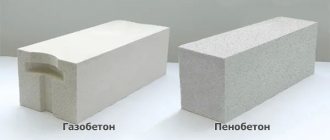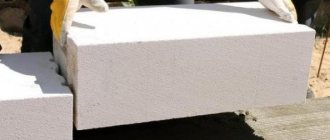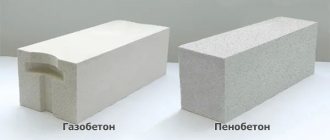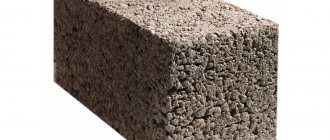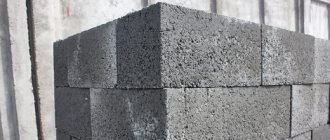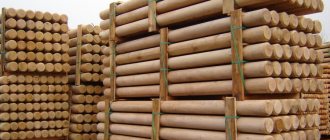Beton-House.com
Website about concrete: construction, characteristics, design. We combine the experience of professionals and private craftsmen in one place
Gas silicate and foam concrete
Comparing materials with each other is a hot topic for many developers. After all, each product has its own strengths and weaknesses, they differ to one degree or another in the features of use and operation. The question of the possibility of independently producing the material at home also remains important.
The use of the most modern materials is widespread among future owners. One of them is products made from cellular concrete. Therefore, in this article we will look for the answer to the question: gas silicate or foam concrete, which is better to choose for construction?
- Main quality indicators
- Necessary raw materials and equipment
Choice for building a house
Silicate porous concrete is used in frame construction to fill the gaps between posts and beams. For multi-story buildings, this method is suitable if additional stiffening belts are installed. In their free form without a frame, blocks and gas silicate are taken for the construction of walls no more than three floors high.
Aerated concrete stones are used in construction:
- private residential buildings, outbuildings, dachas, cottages;
- industrial premises, workshops;
- commercial facilities, stalls, shops, pavilions.
Foam concrete is used for the construction of load-bearing walls and filling spans in frame houses . They are used to make internal partitions and external structures.
Foam blocks are used in construction :
- classic residential buildings;
- with a monolithic construction method;
- for insulating foundations, walls, floors and roofs from cold.
Valera
The voice of the construction guru
Ask a Question
Gas silicate is better or foam concrete, depending on the purpose of construction. For example, aerated concrete is easier to cut and process, and complex wall structures are successfully erected from it. Foam blocks are more suitable for insulating structures because they do not absorb water.
Aerated concrete - well-deserved popularity
Aerated concrete also has well-deserved popularity and its undeniable advantages. To make this building material, quicklime, quartz sand, cement, aluminum powder and water are used. When all these components are mixed, the volume of the raw mixture increases several times due to the release of hydrogen. When aerated concrete hardens, numerous pores form in the material. The result is a material with the highest heat saving performance.
The building material is produced in the form of large, lightweight blocks, which facilitates transportation and speeds up the laying of buildings. Experts note that walls made from this modern material are perfectly smooth and do not require complex finishing.
Aerated concrete walls can be finished with all known materials: siding, wood, facing brick or plaster. In addition, aerated concrete practically does not absorb moisture. For example, the humidity of walls made of aerated concrete in houses in the Northern capital, according to examinations, is no more than 6%. Whereas houses of similar size in St. Petersburg made of coniferous trees have walls with a humidity of up to 20%.
Aerated concrete - large, lightweight, even blocks with the formation of numerous pores, resistant to frost and instant drying Source neanderthals.ru
Comparison of the characteristics of aerated concrete and foam concrete
In the first material, pores are formed by gas bubbles constantly rising to the surface, so the cells are interconnected, and the gas silicate absorbs water in a humid environment . The structure of foam blocks contains closed, isolated bubbles, so the products are not able to absorb moisture.
Differences and similarities in other characteristics:
- Sound insulation is better with foam concrete blocks;
- protects more strongly , but subject to careful waterproofing, since saturation with moisture negates any protective properties;
- both materials have excellent fire resistance , since fireproof components are used as raw materials;
- vapor permeability is better with aerated concrete, and foam blocks “breathe” poorly.
The main difference between gas silicate and foam blocks is in the structure of the internal cells, hence the discrepancy in qualities. Characteristics depend on the brand and density.
Difference in strength
The strength of gas silicate products is higher than that of foam concrete analogues. If we take grades of equal designation (density), gas silicate stones will withstand a stronger load. They keep their original shape and do not crack during transportation and unloading.
The density of handicraft foam blocks may be different in different parts of the product. Aerated blocks have a uniform structure in all areas, since they are not manufactured independently.
Features of selection depending on operating conditions:
- if additional treatment of walls, complex architectural structures, smooth surfaces is needed, use aerated concrete;
- Foam concrete stones are used for insulation and internal walls; they are used for laying basements and insulating foundations, since the products do not conduct moisture.
Aerated concrete is easier to cut and drill with tools without carbide tips. It holds dowels and nails better. Porous materials have less radioactivity - they do not contain mica or crushed granite with natural radiation.
The main differences between foam block and gas block
To understand the issue, you need to refer to the regulatory documents that regulate the production of the above-mentioned materials.
Both types of blocks have similar properties, are similar in appearance and belong to the same type of material - cellular concrete. Products made from such concrete have a porous structure, which makes them “warmer” (low thermal conductivity), but at the same time they retain sufficient strength for the construction of load-bearing walls.
The words “foam concrete” and “aerated concrete” have long been used, but in fact these names do not in any way reflect the composition of the material, because these products are not concrete. Concrete is a composite material consisting of aggregate and binder. The first part of the name usually refers to aggregate (reinforced concrete). The parts “foam” and “gas” here indicate the method of pore formation. In one case it is foam, in the other it is gas.
Foam concrete
The production of this material is regulated by two GOSTs: “25820-2014 Lightweight concrete. Technical specifications" (comes into force on January 1, 2020) and "25485-2012 Cellular concrete. General technical conditions". Foam blocks are made from foam concrete, which are used as building wall material. Main components: cement, water, sand and foaming agent.
Foam concrete differs from aerated concrete in two main ways.
According to the method of hardening, all cellular concretes are divided into autoclave and non-autoclave. Foam concrete belongs to the last category, i.e. it hardens naturally in air (hydration hardening) in removable formwork. In some cases, the formwork immediately divides the material into blocks; sometimes foam concrete is poured into one large block and then cut into pieces.
An autoclave is a sealed container for heating under pressure; the products inside are exposed to steam and high temperatures, so aerated concrete immediately after production is wet (humidity by weight for low-density products can reach 50%).
According to the foaming method, a porous structure in foam concrete is achieved by adding special foaming agents. In liquid form, the material is foamed, and after hardening it remains a porous structure. Bone glue, scrubber paste, etc. can be used as foaming agents.
In GOST, which was in force until 2022, foaming agents were standardized; in the new standard, foaming agents are not specified.
Aerated concrete
It is more correct to call aerated concrete autoclaved cellular concrete. Production is regulated by GOST 31359-2007 “Autoclaved cellular concrete. Technical conditions". Aerated concrete is made from cement, sand, water, lime and a gas-forming agent. The components are similar, but let’s focus on the differences from foam concrete.
The sand is crushed to a fine fraction (2000 - 3000 cm2/kg), this is necessary to form a single mass with cement. Sand for foam concrete is not crushed.
The material is cut before it hardens; no formwork is used for this. Gas blocks are pressed through steel strings.
Hardening occurs in 12 hours in an autoclave. Thanks to this, pore formation occurs more predictably, and the blocks are more uniform.
The formation of cells occurs through the interaction of a gas-forming agent (aluminum powder PAP-1 and PAP-2) with lime and water. As a result, hydrogen is released, which forms pores inside the material.
In some regions, aerated concrete is called gas silicate, but in fact these are different materials. When the production of cellular concrete first began, different compositions were practiced: cement-based, lime-based and mixed. Lime-based products were called gas silicate blocks; now this recipe is practically not used.
Masonry feature
Reinforcement of gas silicate
The difference between foam concrete and gas silicate is that the first material can be laid in any weather, for example, snow, rain. Aerated blocks are placed in a structure only after complete drying; they cannot be installed in fog or mounted in structures on the shores of fresh water bodies or seas. After laying aerated concrete stones, an insulating film from moisture is made, which requires the organization of a ventilated gap to remove condensation.
Differences in reinforcement:
- metal rods are laid after the first row in the masonry of their gas blocks, the next reinforcement is performed every 4 rows;
- iron wire and reinforcement are placed in the foam concrete masonry after the first tier, the subsequent ones are used after 2 - 3 rows.
Along the perimeter of the walls, a reinforced reinforced concrete belt is made from both materials to support floor slabs or load-bearing beams or trusses. For laying gas blocks and foam blocks, use cement-sand mortar or special glue. The first row is always placed on the solution.
Pricing
Of course, one of the answers to the question of how a foam block differs from a gas silicate block lies in the pricing policy. Despite the fact that foam concrete is a little cheaper , this is usually evidence of falsification of the product, or discounts, as well as promotions from sellers.
On average, the price of these materials ranges from 3-4 thousand rubles per cubic meter . The final cost of construction is equalized by the fact that cheaper foam concrete requires higher quality finishing, as well as a more dense reinforcement system, while gas silicate blocks do not require all this.
Return to content
Rules for choosing when purchasing
It is necessary to select blocks with clear dimensions, without chips, and uniform color.
The grade and density of the material are determined by the purpose of use (thermal insulation, partitions or loaded walls).
Pay attention to the quality of the stones:
- uniform color indicates a conscientious manufacturer;
- What matters is the evenness of the surface and adherence to geometry - such products will save glue or mortar when laying;
- the absence of chips, cracks, and swelling indicates compliance with the technology.
The supplier must provide a quality certificate . Factories pack products in film and put them on pallets to reduce the risk of destruction during transportation. Each pallet is marked with parameters. If the blocks are sold in bulk, the risk of buying handicrafts increases.
Core values
Some believe that assessing the environmental safety of a particular material is in most cases “far-fetched.” And, as a rule, it is carried out by the manufacturers themselves. In fact, diagnosing the environmental health of building materials can be quite objective. According to experts in this field, this concept includes the flammability and radioactivity of materials. As for aerated concrete, it is not flammable, which means that talking about the release of dangerous toxins during combustion is not appropriate. As well as the ability to form a smoke screen, spread fire and release harmful gases. Unlike natural wood, beloved by many, which flares up instantly and burns intensely.
| “I would like to talk about the shrinkage of houses made of aerated concrete,” shares Ivan from the Orenburg region . – In any case, it occurs when constructing housing from this material, but this process can be smoothed out. If aerated blocks are left to sit for a month without starting construction, precipitation can actually be avoided. Another rule: a competent approach to finishing the house. Small cracks, which probably cannot be avoided, can be plastered or a reinforcing sheet can be used. |
Which material is warmer?
Which composition retains room heat better? Gas silicate has reduced frost resistance. It is inferior to foam concrete. However, due to the ideal geometric dimensions of gas silicate, it is possible to produce masonry using adhesive compositions. With high-quality fitting of products, cold bridges are reduced and the solidity of the building is achieved. What's warmer?
Due to its high thermal resistance, the foam block accumulates heat well. This allows you to reduce the cost of maintaining a comfortable room temperature. However, for this it is necessary to make walls made of foam concrete 2 times wider than for a building built from gas silicate.
Objects made of gas silicate are warmer. With equal wall thicknesses, they provide a more comfortable thermal regime. It would not be superfluous to insulate the building. This contributes to a comfortable microclimate.
Production specifics
Both wall materials are made of cellular concrete with cavities evenly distributed throughout the mass. The technology and the components included determine the properties of these building composites.
The technology for creating lightweight concrete involves the use of environmentally friendly ingredients. As a result of special manufacturing methods, the blocks are saturated with pores.
How are foam concrete blocks made? Main stages:
Aerated concrete and gas silicate are often confused
Aerated concrete or gas silicate blocks are characterized by the following:
Builder tips
When choosing gas silicate or foam concrete, you need to know what to look for and how to work with these materials correctly. Advice from experts can help with this.
What to look for when choosing a material
Tips for use:
It’s up to you to decide what material to use; the main thing is to make a responsible choice. Answering the question what is the difference between gas silicate blocks and foam blocks, we cannot say with confidence that there are strong differences.
The characteristics of the materials are similar, there are no obvious differences. The main thing that can be highlighted is that foam concrete cannot be used in multi-story construction.
Source
Choosing which is better - gas silicate or foam block
Gas silicate blocks and foam blocks belong to cellular concrete, so these building materials are often confused with each other.
You can find out which gas silicate or foam block is better from this article. They have one scope of application - they are used for the construction of residential and non-residential premises, industrial buildings, and are used for insulating walls.
The composition of the blocks is almost identical, but they are produced under different conditions. Gas silicate blocks are manufactured in a factory, as an autoclave is required. Foam blocks are easy to make, you can make them yourself.
Let's take a closer look at each type of building material, get acquainted with the technical characteristics and properties. Let's find out how gas silicate differs from foam block and what to consider when choosing a material.
Economic aspects
Which materials are cheaper? What is better: foam concrete or silicate products? Let's try to figure it out.
Gas silicate products are produced using expensive equipment using industrial technology. Features of the process require significant costs, which affects the cost of finished products.
The conditions of a small enterprise or construction site make it possible to painlessly produce foam blocks. The equipment is quite cheap. This affects the quality of products and the geometry of finished products, which are inferior to gas silicate.
The costs of construction using gas silicate, which is more expensive than foam concrete, are recouped over the life of the building.
Laying silicate blocks with ideal geometry requires a small amount of special glue. Construction using foam blocks requires a large amount of cement mortar used to level out errors.
Have you decided to build your own house using cellular concrete? Foam concrete or gas silicate are equally suitable for this task. It is important to take into account the recommendations of professionals and compare the characteristics of concrete. We advise you to purchase only high-quality blocks made from cellular raw materials. The durability and strength of your home will be ensured! The choice is yours!
Source
